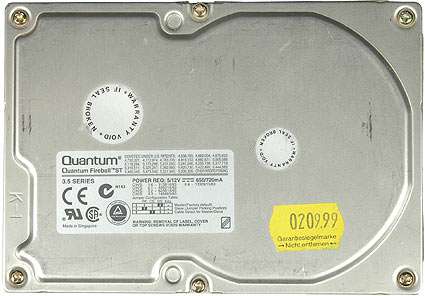15 Years Of Hard Drive History: Capacities Outran Performance
Moving To FAT32 And UltraATA/33: Quantum Fireball ST3.2A (1996)
Quantum's Fireball was available about five years after the 40 GB Maxtor drive discussed above, in capacity points from 1.6 GB to 6.4 GB. As you can imagine, lots of improvements were made between these generations. The Fireball ST 3.2A came with double the cache (128 kB) and a higher rotation speed of 5,400 RPM. This drive was one of the first to make use of the 33 MB/s UltraATA interface, and it implemented magneto-resistive read/write heads for the first time.
We measured an interface bandwidth of 31.3 MB/s, which is very close to the theoretical maximum, while this drive's internal transfer rates were specified to reach 132 Mbit/s (about 16 MB/s). The real data transfer speed off the medium almost reaches 10 MB/s. If you do the math, you will notice that the drive offers 80x the capacity of the Maxtor model - or 50x if you compare the 130 MB top model of the Maxtor 7130A versus the 6.4 GB Fireball - while offering roughly 13x the usable transfer performance.
It was at around this time that users were forced to abandon their old 16-bit FAT file system in favor of alternatives: Windows 95's FAT32, Windows NT's NTFS, HPFS under OS/2, or ext2 under Linux. FAT16 was based on 16-bit clusters, which were chunks of storage allocated by the controller using a cluster number. A single FAT16 cluster held a maximum of 32 kB, which when multiplied by the 65,536 possible addresses of the 16-bit allocation table resulted in a total useable capacity of 2,097,152 bytes or 2 GB.
You could get around this limitation by creating multiple partitions, but the better solution was FAT32, which increased cluster numbers from 16 bits to 28 bits. This allowed for millions of clusters sized from 4 kB to 32 kB, depending on the partition size. FAT32 can theoretically handle up to 2 TB (terabyte) per partition, but since larger capacities inflate the storage space needed for the actual table - 256 MB in the case of a 2,048 GB partition - it was better to use a more advanced file system for larger disks (NTFS for Windows XP or ext3 with journaling for Linux).
Get Tom's Hardware's best news and in-depth reviews, straight to your inbox.
Current page: Moving To FAT32 And UltraATA/33: Quantum Fireball ST3.2A (1996)
Prev Page Hard Drives: 40 MB To 750 GB - 3,500 To 10,000 RPM Next Page 512 kB Cache: IBM DTTA-351010 (1998)
Patrick Schmid was the editor-in-chief for Tom's Hardware from 2005 to 2006. He wrote numerous articles on a wide range of hardware topics, including storage, CPUs, and system builds.
-
There is a typo in the article:Reply
Quantum's Fireball was available about five years after the 40 GB Maxtor drive discussed above,
It should be 40MB, obviously -
badcat "And Samsung, finally, may have a decent advantage in the future with a possible hybrid hard drive; it is the only firm in this quartet that manufactures both magnetic and Flash storage." WRONG! This technology existed in enterprise level hard disks for some time now.Reply


